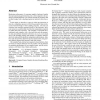Free Online Productivity Tools
i2Speak
i2Symbol
i2OCR
iTex2Img
iWeb2Print
iWeb2Shot
i2Type
iPdf2Split
iPdf2Merge
i2Bopomofo
i2Arabic
i2Style
i2Image
i2PDF
iLatex2Rtf
Sci2ools
TOG
2002
2002
Shader-driven compilation of rendering assets
Rendering performance of consumer graphics hardware benefits from pre-processing geometric data into a form targeted to the underlying API and hardware. The various elements of geometric data are then coupled with a shading program at runtime to draw the asset. In this paper we describe a system in which pre-processing is done in a compilation process in which the geometric data are processed with knowledge of their shading programs. The data are converted into structures targeted directly to the hardware, and a code stream is assembled that describes the manipulations required to render these data structures. Our compiler is structured like a traditional code compiler, with a front end that reads the geometric data and attributes (hereafter referred to as an art asset) output from a 3D modeling package and shaders in a platform independent form and performs platform-independent optimizations, and a back end that performs platform-specific optimizations and generates platform-targeted...
| Added | 23 Dec 2010 |
| Updated | 23 Dec 2010 |
| Type | Journal |
| Year | 2002 |
| Where | TOG |
| Authors | Paul Lalonde, Eric Schenk |
Comments (0)

